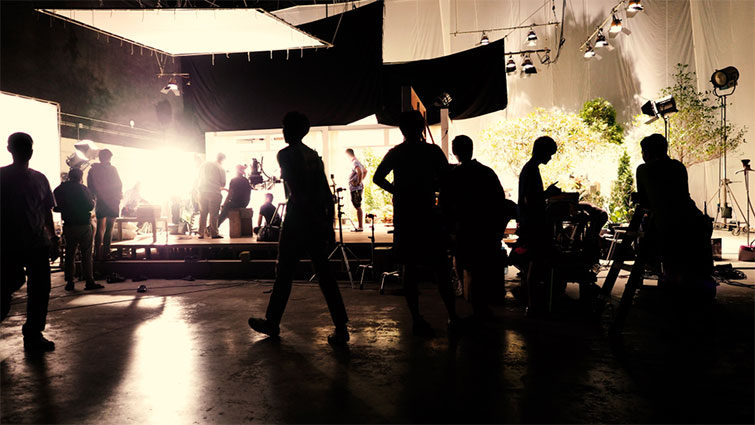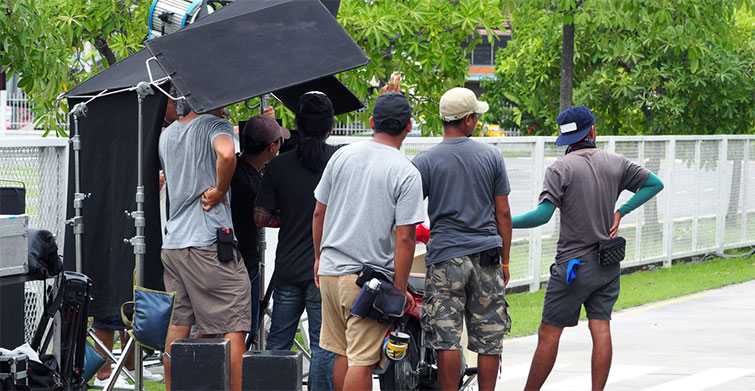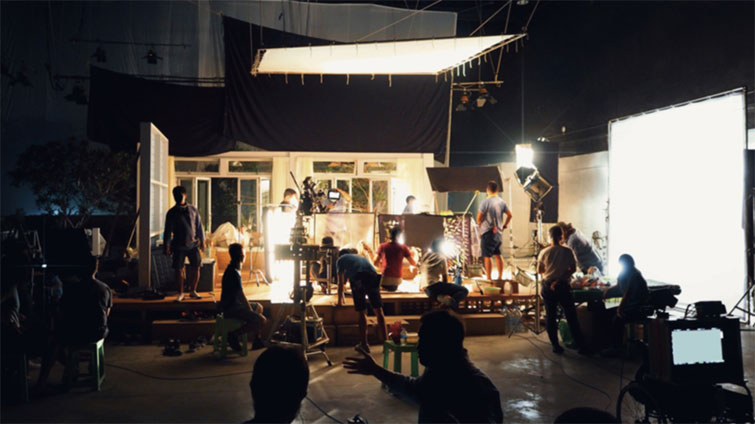
Production Tips: Walkie Talkie Codes and Etiquette on Set
Efficient radio communication on set keeps productions moving quickly. Here’s what you need to know to join the conversation.
The efficiency of radio communication on set depends on the knowledge and discipline of the crew members using the radios. To increase productivity, crews rely on codified forms of communication on set to quickly and clearly convey information or requests.
In this article, we’ll take a look at some of the basics of walkie communication.
Channel Management

Image via gnepphoto.
Radio communication is the backbone of most sets. Walkies help the crew stay productive — even during quiet moments. Radios also keep the crew connected when they’re out of sight or speaking distance. Good comms makes productions move faster and more efficiently.
Productions will usually have either one or a small handful of channels designated as general communication channels for the entire crew to use. When not actively communicating, this should be where you keep your walkie parked. The remaining channels are reserved for different departments.
When someone needs you, they will call for you, you will respond to the call, and they will tell you to “go to” another one of the specified channels. You will both flip over to that channel to continue the discussion without interrupting the general channels. Once done, you will both flip back to the designated general channel.
Here are some general walkie tips that will help you out during your first few days on set.
Walkie Codes for your first production

Image via gnepphoto.
Speak Clearly
When speaking, communicate confidently and succinctly. Before you hit the transmit button and start talking, take a moment to repeat the call you want to give a few times in your head. Make sure you know what you need, whom you need, and how you are going to say what you need to say.
Observe Channel Rules
Don’t chat in the general channels. These channels are for quickly connecting with other crew members or to share announcements. If you are talking in one of them beyond a simple “go to” or a quick remark or request, your crew mates will become frustrated with you.
Learn the Voices of the Crew
At the very least, learn the voices of those members of the crew with whom you interact regularly. It’s fine to ask whom you’re speaking with for the first week or so of a production, but after that, you are at moderately high risk for being thought of as a little rude — or at least a little slow on the uptake. Pay attention to who is speaking on the radios most often, match faces to names, and quiz yourself from time to time when you hear a voice you don’t recognize.
Now that we’ve got a few of the basics down, let’s take a quick look at some of the codes you’ll hear on set.
Set Radio Codes

Image via gnepphoto.
I won’t attempt to provide an exhaustive list of radio callouts and codes; instead, I’ll focus on those you’re most likely to hear during your first few days of production.
-
Go To
As I mentioned, most productions will designate radio channels for different departments — and others for general crew use. When someone calls for you to “Go to channel 8,” for example, they need to have a more detailed conversation with you than general channels will allow. Both you and the other party switch to channel 8 (in this example) and continue your conversation there.
-
What’s your 20?
20 is short for location. This is one of the most common radio calls.
-
Copy and 10-4
Both “copy” and 10-4 are slang for an affirmative response, and for the most part, may be used interchangeably. More than simply “yes,” they imply that you understood the preceding request and are moving to act on it.
-
10-1 and 10-2 (10-100 and 10-200)
These are bathroom calls. I’ll let you figure out the difference between the two.
-
Go again
I’ve heard a few variations of this one on different sets, but “Go Again” is a common response when the other party needs you to repeat yourself.
-
Flying in/out
Flying in or out just means that someone or something is being brought to or taken from set. You’ll hear it used all over set, not just over the radio.
-
Keying or hot mic’ing
This is another one that has a few common variations in wording, depending on the crew or production. Essentially “keying” or “hot mic’ing” means that someone is accidentally holding the transmit button on their radio and disrupting communications. Mess this up enough and you are going to lose your walkie.
If you ever get a code that you don’t understand, ask the other person to “go again.” If you still don’t understand the request, tell them to “go to” an appropriate channel to explain in full.
With these basics, you should be all set for your first day. Pay attention to the codes you hear other members of the crew using, and you should get a good feel for most of the codes within your first week or so on set.
Cover image via zhgee.
Looking for more video production tips and tricks? Check out these articles.
- Directing Fight Cinematography: The Right Way and the Wrong Way
- Production Tips: What to Expect on Your First Film or Video Set
- Understanding Tax Incentives in the Filmmaking Industry
- This DIY Roger Deakins Style Ring Light Costs Less Than $150
- Understanding Image Noise in Your Film and Video Projects





